Alpine
Autonomy Techniques 2026
Learn skills for Alpine independence | Fast track skills course    |
|
|
|
|
|
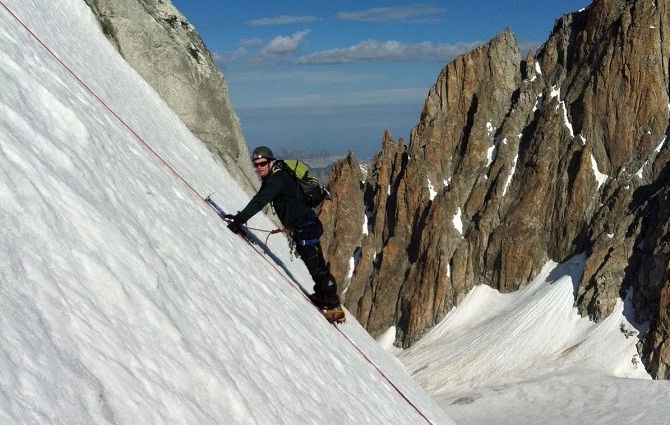 |
|
Course
overview

 |
 |
If
you have previous climbing or crampon
experience, and want a fast track course
that is designed to make you more autonomous
in the Alps, this is the course for
you. You cover all the technical syllabus
of the Introduction course in greater
detail, with greater focus on route
finding and equipment selection. |
 |
On
this course there is a real focus on
climbing in some of the most stunning
areas of the Mont Blanc massif, as well
as learning skills that will be useful
in your climbing after the course. The
course culminates in the ascent of a
quiet and remote summit, such as the
traverse of the Domes du Miages. |
 |
The
technical content will be tailored to
build on your current experience, with
an emphasis on glacier travel and crevasse
rescue on both dry and wet glaciers.
The course also covers a whole host
of ropework and Alpine safety issues
such as avalanche awareness, belays
and anchors, crampon and ice axe techniques. |
 |
Autonomy is a continuum. There is no one point that you become completely autonomous. The level of autonomy required to safely traverse a glacier, is very different from that to climb the Matterhorn. It's a journey of many stages of development, consolidation, and practice. This course gives that process a boost. |
 |
This
course is set at just above the level
of the Introduction course (summer or
winter), so if you have a bit too much
experience (such as previous rock climbing
experience) this course is for you.
The vast majority of the routes ascended
are of the Alpine PD grade (roughly
equivalent to Scottish Grade II/III). |
 |
Many
clients are pleasantly surprised how
much chance they get to learn, and how
autonomous they really become over the
week. We have seen several teams set
off to climb their first 4000m peaks
on their own, after the course, and
this course really is a complete Alpine
apprenticeship that works. |
 |
Updated itinerary to promote learning, and to provide two days 1:2 guiding for more routes focus at the end of the week, as well as improved ratios for the techniques and skills training days at 1:4 ratio. |
 |
Dates: these
are listed in the column on the right,
and they show the live availability
from our secure online booking system.
When you book online, you receive immediate
confirmation, your Alpine Information
Booklet, course specific kit list and
invoice. |
|
|

|
|

Brief
Course Itinerary

 |
 |
 |
Day 1 | Sunday
Travel to Chamonix. Accommodation check in at 17:00. Mont Blanc specific course safety and itinerary briefing at 17:30.
There is time for kit checks or fitting rental equipment after.
Briefings are over by 18:30 and then you are free to go out for dinner / drinks. Many clients opt
to travel out a day or two early to start their acclimatisation at Aiguille du Midi or with a night in a mountain hut (e.g. Cosmiques or Albert 1er). Night in Chamonix.

 Gallery: Chamonix town Gallery: Chamonix town |
 |
 |
 |
 |
 |
Day 2 | Monday
Day
to learn and practice using crampons and ice axes
on the Mer de Glace / Argentiere glacier (2000m). You climb
vertical ice, create ice anchors, and learn glacier
travel skills. This is one of your most important
days of the course in terms of skills development
as it is essential to have good footwork with crampons. Guiding ratio 1:4 (max). Evening
theory session / meeting with course hosts: click
for info.
Night in Chamonix.

 Gallery: Mer de Glace Gallery: Mer de Glace |
 |
 |
 |
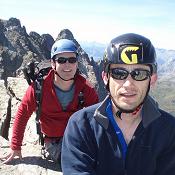 |
 |
Day 3 | Tuesday
Flexible itinerary to adapt to existing skills, and balance of learning and climbing. Possible routes include Traverse of Aiguille
du Crochues or Mic et Maousse, to focus on ropework, moving
together, anchors, etc. The
route chosen for this day is generally a mixed
route that is ascended in mountain boots rather
than rock shoes. Guiding ratio 1:4 (max). Evening
theory session / meeting with course hosts: click
for info.
Night in Chamonix.

 Gallery: Autonomy skills Gallery: Autonomy skills |
 |
 |
 |
 |
 |
Day 4 | Wednesday
Today is a perfect chance to develop crevasse rescue skills, and there are good locations near Midi or Helbronner. Alternatively climb a snowy summit, perhaps as one guided, and one independent team undersupervision of the guide with the other team. Ascents such as Petit Flambeau, or one peak of Marbrees or Lachenal. Guiding ratio 1:4 (max). Evening
theory session / meeting with course hosts: click
for info. Night in Chamonix.

 Gallery: Petite Aiguille Verte Gallery: Petite Aiguille Verte |
 |
 |
 |
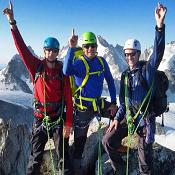 |
 |
Day 5 | Thursday
The
start of a two day route with a night in a
mountain hut (half board hut not included for you and guide), or a day route. You
decide the itinerary for the last two days
of this course. Typically groups ascend the
Domes du Miages, Aiguille du Tour, Petite
Forche, or Mont Blanc du Tacul, and the route
chosen is a reflection of your autonomy skills
development and of the conditions. Guiding ratio 1:2 (max). Night in mountain hut / Chamonix.

 Gallery: Aiguille du Tour Gallery: Aiguille du Tour |
 |
 |
 |
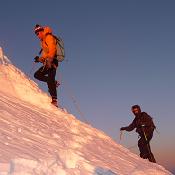 |
 |
Day 6 | Friday
If
you opted for a two day route, then today
will be an Alpine start from the mountain
hut to ascend one of the peaks mentioned on
the previous day, or it could also be another
day route e.g. Cosmiques Arete / Marbrees / Entreves / Chapelle de la Gliere. After
the main ascent of the week, you descend back
to the Chamonix valley. Guiding ratio 1:2
(max). Evening social drinks, then a celebratory
meal, with the final night spent in Chamonix.

 Gallery: Autonomy week Gallery: Autonomy week |
 |
 |
 |
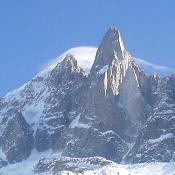 |
 |
Day 7 | Saturday
Breakfast then the accommodation check out by
10:00. Most arrange transfers for around this
time for a flight from Geneva about midday. Some
opt to book a tandem paraglider flight in
the morning, or to go rafting, mountain biking, or trail running, if you still have the energy! Our resort team can advise you on where to arrange any of this, or routes. For those departing late, bags can be stored during the day. Depart for home.

 Gallery: Icicle Windermere office Gallery: Icicle Windermere office |
|
 |
| ITINERARY
NOTES: Where possible we follow itineraries. Mountain
adventures are weather and conditions dependant,
so occasionaly we are forced to alter the plans.
If this is the case, suitable alternatives are offered.
Please use this outline itinerary as a guide to
the types of route / activity that you will attempt. |

|
|
 |
| Course
Prices |
 |
| Standard
course |
5 days guiding, 7 days holiday in total
IFMGA mountain guides for 5 days |
£1495 |
| Live
availability |
Click
on the planner logo to the right to
see the real time live course availability
|
 |
| How to book |
Secure
payments, bonded tour operator
Details of how to book, click
here |
Book
online |
|
|
 |
| Standard
Course Inclusions |
 |
 |
1) Hand picked IFMGA Mountain Guide(s), including 5 days guided activities |
 |
2) Chamonix course hosts for briefings, logistics, expert advice, and support |
 |
3) Pre course information dossier, with training plans and specific kit lists |
 |
4) Safety briefing on the first evening, with latest updates and weather reports |
 |
5) Equipment discount voucher for our Windermere mountain shop / online |
 |
6) Self-catered flat in Chamonix for 6 nights, with no moving out when in huts |
 |
7) Road transport with your guide within the Chamonix valley, as required |
 |
8) Evening drop-in sessions for instruction / route briefings / equipment advice |
 |
9) Free 36 page
technical Course Instruction Booklet of Alpine safety skills |
|
 |
| Exclusions:
1) Travel to and from Chamonix, 2) Equipment hire,
3) Cable cars & uplift for you, and your guide (if required), 4) Personal laundry,
telephone calls, lunches, evening meals in valley,
& any purchases in mountain huts / hotels /
restaurants, 5) Optional night half board in mountain
hut (inc. costs for guides), 6) Sunday pre-dinner
drinks & Friday celebratory meal & drinks,
7) Activities insurance, & excess baggage charges. |
 |
 |
Course
upgrade options
Many clients on this
trip consider upgrading with one or more of
the following course additions... |
|
 |
 |
| |
 |
 |
Private
room |
|
 |
 |
Big
5 Alpine
extensions |
|
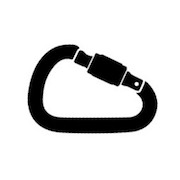 |
 |
Technical
kit rental |
|
 |
 |
Acclimatise
weekend |
|
 |
 |
 |
 |
 |
| |
Upgrade
to single from
£300-£500 in addition to
standard course price,
depending on week. |
Extend by 2 days after
to ascend one of the
Big 5 Alpine peaks as
an extra summit. |
Rent all technical kit
for a week. Full Alpine
Bundle costs you just
£100 for the week. |
Saturday
night spent in
Chamonix, with choice
of self-guided or guided
on Sunday. From £70. |
| |
Click
for details |
Click
for details |
Click
for details |
Click
for details |
| |

Standard
course accommodation - normally clients are based
in self-catered flats (details),
so take a look, and decide if it's for you. For
more luxury, contact us for quotes in higher standard
apartments, or hotels of any standard required.
If you have / source your own course accommodation,
or we cannot provide an upgrade, the standard course
price has a £200pp reduction applied on your
invoice. |
|
 |
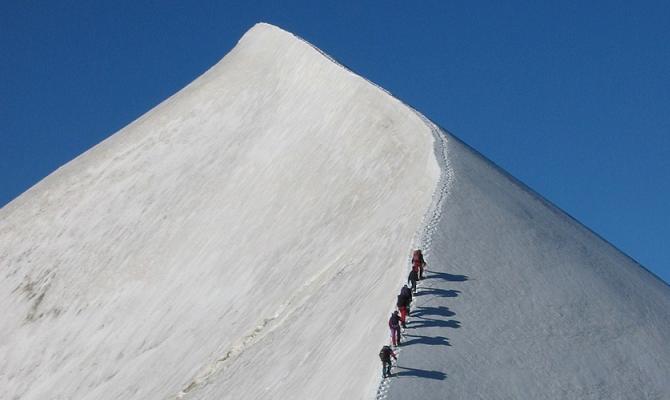 |
|
 |
Current
course availability

 |
|
| Testimonials |
|
|
|
 |
 |
 |
 |
| Press
& media |
|
|
|
 |
| Films
& videos |
|
|
|
 |
| Photo
gallery |
|
|
|
|
 |
| Location
data for this trip |
 |
 |
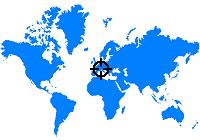 |
 |
| The
trips are based in the Chamonix valley in the French
Alps, at the foot of Mont Blanc. It is easily accessed
via a 90 minute transfer from Geneva airport. |
 |
Time
Difference
GMT +1hr |
Local
Currency
€ Euros |
Travel
from UK
1hr flight |
|
 |
| Pre-requisite
experience |
 |
 |
For
this course there is a large quantity of technical
instruction and skills elements, with a wide range
of routes that can be climbed during the week. Please
ensure that you have all the pre-requisite skills
and experience requirements for this course. If
you are unsure at all, please ask us to help advise
you;

 Crampons - have used crampons, even for winter
skills / walking Crampons - have used crampons, even for winter
skills / walking

 Rock - if no outdoor rock experience, to be a capable
scrambler Rock - if no outdoor rock experience, to be a capable
scrambler

 Ropework - be able to tie on to a rope, and to belay safety Ropework - be able to tie on to a rope, and to belay safety

 Fitness - to be similar fitness to those attempting Mont
Blanc Fitness - to be similar fitness to those attempting Mont
Blanc |
 |
| Alpine
skills & knowledge |
 |
 |
Try
to answer the questions below, and see how much
you already know. The answers are beneath. After
you complete one of these courses, you should be
able to answer all these questions, and much more
with the greatest of ease.

Q1.
What is the minimum length rope two climbers should
take for a wet glacier crossing?

ANSWER:
They should take a 30m rope, as a wet glacier is
snow covered, so crevasses could be hidden. Each
climber should tie on the end of the rope and take
in chest coild until 10 to 12 metres are tied off
between them.

Q2.
What is a foehn wind, and how is it generated?

ANSWER:
A foehn wind is caused by the enforced uplift of
an airmass over a mountain, and as it cools with
altitude the humity condenses and precipitation
falls. On the descent the drier air mass is rapidy
compressed and warms quickly. The net effect is
that the air reaches the same altitude on the far
side of the mountain drier and warmer than on the
uplift side.

Q3.
How can you retreat from a multi-pitch ice / glacier
climb without leaving any ice screws behind?

ANSWER:
By constructing Abalakov belay systems, which are
two inter-connecting holes drilled into the ice,
using ice screws, through which some abseil tat
is threaded and tied off.

Q4.
How do you tell a left and right crampon apart?

ANSWER:
The buckles / strap attachments are always on the
outside of the crampon, to reduce the snagging /
trip hazard. Also looking a the crampons from above,
a left boot crampon bends to the right, and vice-versa. |
 |
| Suggested
reading and kit |
 |
 |
|
 |
 |
View
full course equipment list,
with examples of kit, click
here |
|
 |
| Why
choose our trips? |
 |
 |
 |
See
our Alpine blog, by clicking on the Word-press
logo to the right. |
|
 |
Itinerary
flexibility to allow you to take full advantage
of the weather windows on any day, to maximise
your summit chances. |
 |
Our
prices are fixed in £ Sterling, to protect
you from euro fluctuations, so you can budget
accurately. |
 |
There
is a choice of routes to opt for, depending
on the weather, conditions, and your experience. |
|
 |
| Any
further questions? |
 |
 |
A
key part of choosing a company is being able to
come and talk about your plans with an experienced
course advisor face to face. In an increasingly
virtual world, we know our clients value speaking
to real people, getting open and honest advice.
The vast majority of our clients are British, and
our office and outdoor store is based in Windermere
in the English Lake District.

 

Get
in contact to arrange a meeting, and come in for
a coffee to discuss your course in person with a trip
advisor. |
|

